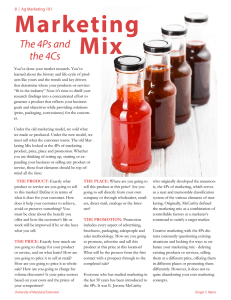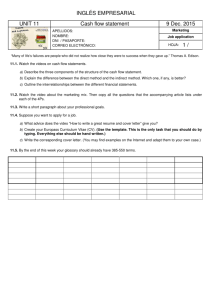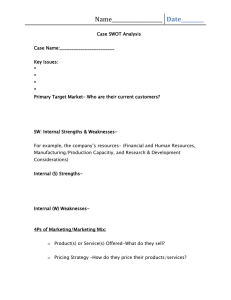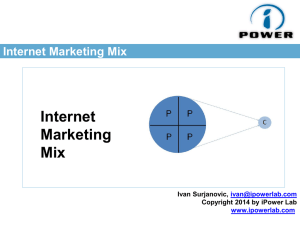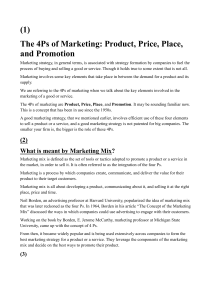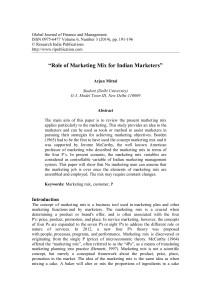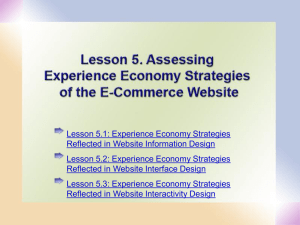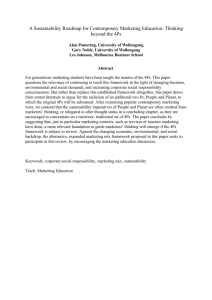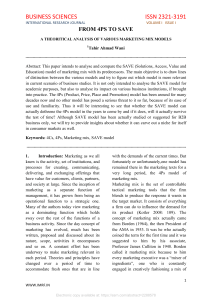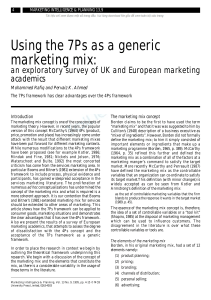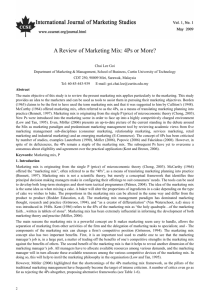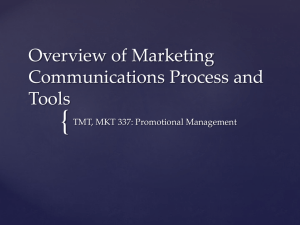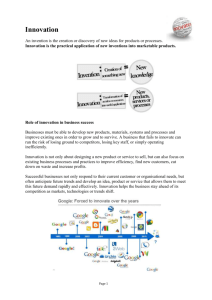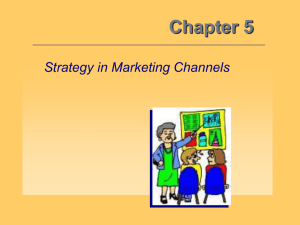M Mix - cda college
advertisement
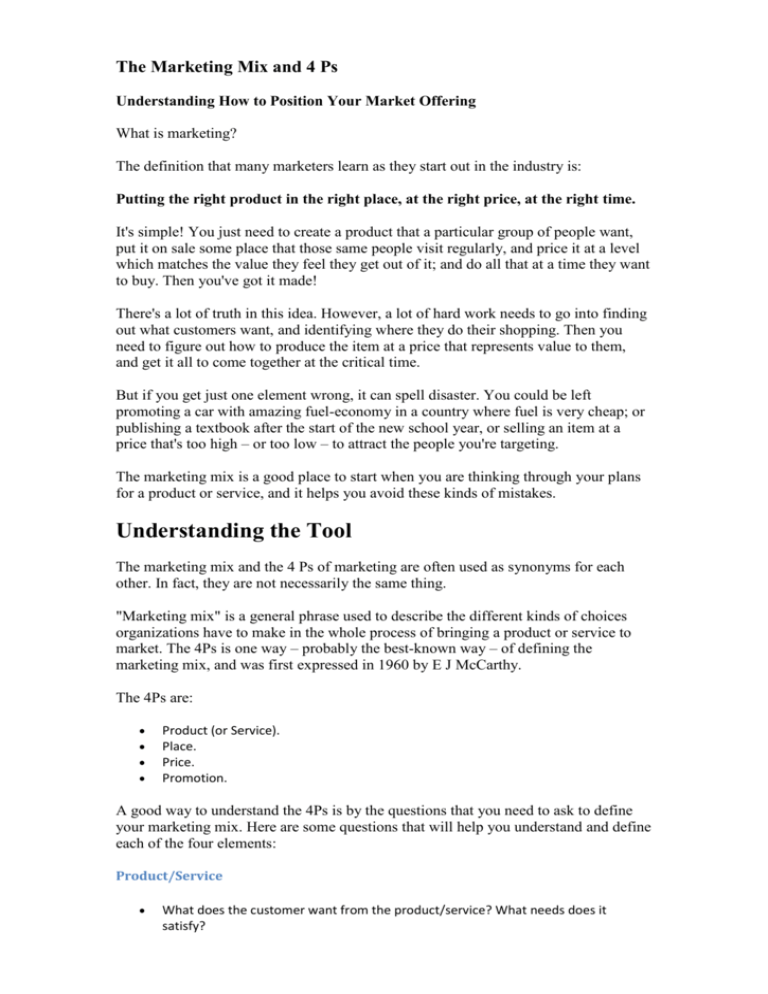
The Marketing Mix and 4 Ps Understanding How to Position Your Market Offering What is marketing? The definition that many marketers learn as they start out in the industry is: Putting the right product in the right place, at the right price, at the right time. It's simple! You just need to create a product that a particular group of people want, put it on sale some place that those same people visit regularly, and price it at a level which matches the value they feel they get out of it; and do all that at a time they want to buy. Then you've got it made! There's a lot of truth in this idea. However, a lot of hard work needs to go into finding out what customers want, and identifying where they do their shopping. Then you need to figure out how to produce the item at a price that represents value to them, and get it all to come together at the critical time. But if you get just one element wrong, it can spell disaster. You could be left promoting a car with amazing fuel-economy in a country where fuel is very cheap; or publishing a textbook after the start of the new school year, or selling an item at a price that's too high – or too low – to attract the people you're targeting. The marketing mix is a good place to start when you are thinking through your plans for a product or service, and it helps you avoid these kinds of mistakes. Understanding the Tool The marketing mix and the 4 Ps of marketing are often used as synonyms for each other. In fact, they are not necessarily the same thing. "Marketing mix" is a general phrase used to describe the different kinds of choices organizations have to make in the whole process of bringing a product or service to market. The 4Ps is one way – probably the best-known way – of defining the marketing mix, and was first expressed in 1960 by E J McCarthy. The 4Ps are: Product (or Service). Place. Price. Promotion. A good way to understand the 4Ps is by the questions that you need to ask to define your marketing mix. Here are some questions that will help you understand and define each of the four elements: Product/Service What does the customer want from the product/service? What needs does it satisfy? What features does it have to meet these needs? Are there any features you've missed out? Are you including costly features that the customer won't actually use? How and where will the customer use it? What does it look like? How will customers experience it? What size(s), color(s), and so on, should it be? What is it to be called? How is it branded? How is it differentiated versus your competitors? What is the most it can cost to provide, and still be sold sufficiently profitably? (See also Price, below). Place Where do buyers look for your product or service? If they look in a store, what kind? A specialist boutique or in a supermarket, or both? Or online? Or direct, via a catalogue? How can you access the right distribution channels? Do you need to use a sales force? Or attend trade fairs? Or make online submissions? Or send samples to catalogue companies? What do you competitors do, and how can you learn from that and/or differentiate? Price What is the value of the product or service to the buyer? Are there established price points for products or services in this area? Is the customer price sensitive? Will a small decrease in price gain you extra market share? Or will a small increase be indiscernible, and so gain you extra profit margin? What discounts should be offered to trade customers, or to other specific segments of your market? How will your price compare with your competitors? Promotion Where and when can you get across your marketing messages to your target market? Will you reach your audience by advertising in the press, or on TV, or radio, or on billboards? By using direct marketing mailshot? Through PR? On the Internet? When is the best time to promote? Is there seasonality in the market? Are there any wider environmental issues that suggest or dictate the timing of your market launch, or the timing of subsequent promotions? How do your competitors do their promotions? And how does that influence your choice of promotional activity? The 4Ps model is just one of many marketing mix lists that have been developed over the years. And, whilst the questions we have listed above are key, they are just a subset of the detailed probing that may be required to optimize your marketing mix. Amongst the other marketing mix models have been developed over the years is Boom and Bitner's 7Ps, sometimes called the extended marketing mix, which include the first 4 Ps, plus people, processes and physical layout decisions. Another marketing mix approach is Lauterborn's 4Cs, which presents the elements of the marketing mix from the buyer's, rather than the seller's, perspective. It is made up of Customer needs and wants (the equivalent of product), Cost (price), Convenience (place) and Communication (promotion). In this article, we focus on the 4Ps model as it is the most well-recognized, and contains the core elements of a good marketing mix. Using the 4Ps Marketing Mix Model The marketing mix model can be used to help you decide how to take a new offer to market. It can also be used to test your existing marketing strategy. Whether you are considering a new or existing offer, follow the steps below help you define and improve your marketing mix. 1. Start by identifying the product or service that you want to analyze. 2. Now go through and answer the 4Ps questions – as defined in detail above. 3. Try asking "why" and "what if" questions too, to challenge your offer. For example, ask why your target audience needs a particular feature. What if you drop your price by 5%? What if you offer more colors? Why sell through wholesalers rather than direct channels? What if you improve PR rather than rely on TV advertising? 3. Tip: Check through your answers to make sure they are based on sound knowledge and facts. If there are doubts about your assumptions, identify any market research, or facts and figures that you may need to gather. 4. Once you have a well-defined marketing mix, try "testing" the overall offer from the customer's perspective, by asking customer focused questions: 1. Does it meet their needs? (product) 2. Will they find it where they shop? (place) 3. Will they consider it's priced favorably? (price) 4. And will the marketing communications reach them? (promotion) 5. Keep on asking questions and making changes to your mix until you are satisfied that you have optimized your marketing mix, given the information and facts and figures you have available. 6. Review you marketing mix regularly, as some elements will need to change as the product or service, and its market, grow, mature and adapt in an ever-changing competitive environment. Key Points The marketing mix helps you define the marketing elements for successfully positioning your market offer. One of the best known models is the Four Ps, which helps you define your marketing options in terms of product, place, price and promotion. Use the model when you are planning a new venture, or evaluating an existing offer, to optimize the impact with your target market.
